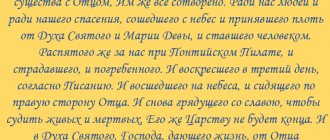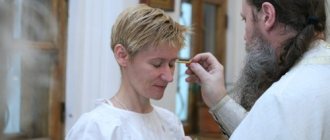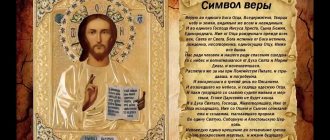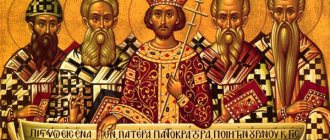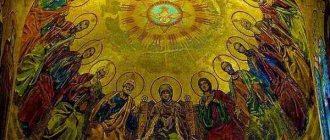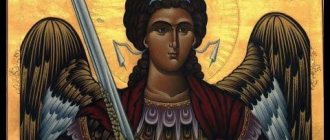The Creed - a summary of the dogmas of the Church
- I believe in one God the Father, Almighty, Creator of heaven and earth, visible to all and invisible.
- And in one Lord Jesus Christ, the Son of God, the only begotten, who was born of the Father before all ages; Light from Light, true God from true God, born, uncreated, consubstantial with the Father, to Whom all things were.
- For our sake, man and our salvation came down from heaven and became incarnate from the Holy Spirit and the Virgin Mary, and became human.
- She was crucified for us under Pontius Pilate, and suffered and was buried.
- And he rose again on the third day according to the Scriptures.
- And ascended into heaven, and sits at the right hand of the Father.
- And again the coming one will be judged with glory by the living and the dead, His Kingdom will have no end.
- And in the Holy Spirit, the Lord, the Life-Giving One, who proceeds from the Father, who with the Father and the Son is worshiped and glorified, who spoke the prophets.
- Into one Holy, Catholic and Apostolic Church.
- I confess one baptism for the remission of sins.
- I drink the resurrection of the dead,
- and the life of the next century. Amen.
Large print and accents
I believe in one God the Father, Almighty, Creator of heaven and earth, visible to all and invisible.
And in one Lord Jesus Christ, the Son of God, the Only Begotten, and begotten of the Father before all ages; Light is from the Light, God and is true from God and is true, begotten, uncreated, consubstantial with the Father, and all things are.
For us, for the sake of man and for our sake, for the sake of salvation, who came from heaven and was incarnate from the Holy Spirit and Mary and the Virgin, and became human.
He was crucified for us under Pontius Pylus, and suffered, and was buried.
And he rose again on the third day according to Scripture.
And he ascended into heaven, and sat down at the right hand of the Father.
And when He is coming with glory, He will judge the living and the dead, and His Kingdom will have no end.
And in the Holy Spirit, the life-giving Lord, and proceeding from the Father, and with the Father and the Son, we are worshiped and praised, who spoke the prophet ki.
In one Holy, Catholic and Apostolic Church.
I confess only baptism for the remission of sins.
I drink the resurrection of the dead,
and the life of the future century. Amen.
With this, I want to say goodbye to you and wish you the brightest and most joyful weekends, holidays and family events. Share this article or discuss with your friends on social networks. Surely you will do a good deed.
Symbol of faith
Symbol of faith
The Creed is composed of the words of Holy Scripture. The Creed , or “I Believe ,” contains all the saving truths (dogmas) about the Holy Trinity and the Orthodox Faith. The Creed is divided into 12 parts, which even kids learn by heart. It is sung by the entire church at the Liturgy, the main church service. Without knowledge of the Creed, it is impossible to fulfill the rule of St. Seraphim. Moreover, whoever does not internalize the truths embodied in the Creed is not a Christian at all!
- . I believe in one God, the Father, Almighty, Creator of heaven and earth, visible to all and invisible. {I believe - I believe, I am convinced; Almighty - the One who holds and controls everything by His power} I believe in one God the Father, Almighty, Creator of heaven and earth, everything visible and invisible.
- . And in one Lord Jesus Christ, the Son of God, the only begotten, who was born of the Father before all ages; Light from Light, true God from true God, born, uncreated, consubstantial with the Father, to Whom all things were. {edinago - one, only; Izhe - Which; before all ages - before all time, from eternity; consubstantial with the Father - having the same being (nature) with God the Father; And through him all things came into existence—and by Him, that is, by the Son of God, all things were created} And in one Lord Jesus Christ, the Son of God, the Only Begotten, begotten of the Father before all ages; Light from Light, true God from true God, begotten, uncreated, one Being with the Father, who created the whole world through His Son.
- . For our sake, man and ours for the sake of salvation came down from heaven and became incarnate from the Holy Spirit and the Virgin Mary, and became human. becoming human - becoming a man like us, but not ceasing to be God} For us, people, and for our salvation, he came down from Heaven, took flesh from the Holy Spirit and the Virgin Mary and became a man.
- . He was crucified for us under Pontius Pilate, and suffered and was buried. {for us - for us; buried - laid in a coffin} Crucified for us under Pontius Pilate, suffered and buried.
- . and resurrected on the third day according to the scripture. {resurrected - revived; according to the scriptures - according to the Holy Scriptures, in which the prophets foretold that He would rise from the dead on the third day}And rose again on the third day, according to the writings (of the prophets).
- . and ascended into heaven, and sits at the right hand of the Father. {ascended - ascended; at the right hand - on the right side of God the Father}And ascended into Heaven and sits at the right hand of the Father.
- . and again the one who comes with glory will be judged alive and dead, His Kingdom will have no end. {again - again, a second time; dead - we are talking about the dead, whose bodies will then be resurrected; There will be no end to His Kingdom - after the Judgment, His endless Kingdom will come} And again He will come in glory to judge the living and the dead, Whose Kingdom will have no end.
- . and in the Holy Spirit, the Lord, the Life-Giving One, who proceeds from the Father, who is with the Father and the Son, worshiped and glorified, who spoke the prophets. worshiped and glorified - the Holy Spirit should be worshiped and glorified equally with the Father and the Son, that is, the Holy Spirit is equal to God the Father and God the Son; who spoke to the prophet - the Holy Spirit spoke through the prophets} (I believe) and in the Holy Spirit, the Lord, the giver of life, who comes from the Father, worshiped and glorified equally with the Father and the Son, who spoke through the prophets.
- Into one Holy, Catholic and Apostolic Church. {Into one - one, only; Conciliar - consonant, unanimous, embracing the Orthodox people of the universe from all nations and all times; Apostolic founded by the apostles of Christ and faithful in all their teaching.} (I believe) in one Holy Catholic (universal) and Apostolic Church.
- . I confess one baptism for the remission of sins. {I confess - I openly acknowledge in word and deed; one - only one} I confess one Baptism, by which forgiveness of all sins is granted by God.
- . and I look forward to the resurrection of the dead, {I look forward to tea, I believe} I look forward to the resurrection of the dead,
- and the life of the next century. Amen.{and the life of the next century - eternal life that will come after the general Judgment}And the life of the next century. Truly so.
Orthodox Life
Archpriest Vladimir Puchkov answers a seemingly simple question.
For several years now I have been working with those wishing to be baptized, as well as with potential godparents and parents who come to baptize their children. I explain what is necessary, conduct special conversations, make appointments for specific days, arrange baptisms by time... Of course, in the process of interaction, as a rule, many questions arise. From simple ones: what temperature will the water be in the font and which godparent should hold the child to more complex ones: what, for example, are the responsibilities of godparents and what is the meaning of Baptism? However, the last two questions are not asked by the godparents, but by me.
But the real stumbling block is often the Creed. “You said to learn the Creed, but this prayer is in Old Church Slavonic and I can’t understand anything,” I don’t know how many times during my ministry I heard something like this. In any case, I managed to get used to them a long time ago. To understand the unlucky godparents, on the one hand, you can: learn the whole prayer by heart, and the text of the Creed, although not the most voluminous, cannot be called particularly short, plus it is in Old Church Slavonic, which is good the first time if you understand a word after two. Confession of faith in itself cannot be simple; in addition, the prayer must not be read, but learned, which is doubly difficult. And here is the text in Old Church Slavonic (or, if you prefer, in Church Slavonic), which you need to first parse and at least try to understand the meaning. And even these accents... Indeed, prayer with the correct accents is now a rarity even among church people (one has “the tree of Poland,” another has “no imams of boldness,” and almost every second person calls a sign a sign). Add to this words like “consubstantial” or “consecrated”, which we even use in speech once, but are not used by non-church people at all. However, in addition to the emphasis, other words get their due: in twenty years of priesthood I have heard a lot from godparents who tried to overcome the Creed on the first try, and Christ, in their opinion, rose “according to schedule” and this happened with them “under Pantelei Pilate”... Those present don’t care, but for a priest to listen to something like this is only to test his own self-control.
On the other hand, the need to read the Creed in Old Church Slavonic should not be particularly embarrassing. It is well known that our Church has its own liturgical language. A language that is not alien to us and is generally understandable to a native speaker of either Russian or Ukrainian, subject to attention and a thoughtful approach. Yes, it can be difficult to learn specific rules, unusual phrases and new words. However, what can you do, they don’t call you godparents every day. On this occasion, you can strain yourself. Take the same text of the prayer Creed in Old Church Slavonic, look it over carefully, don’t be lazy to find out the meaning of unknown words (which nowadays, thanks to the Internet, is as easy as shelling pears), pay attention to the accents, fortunately they are above each word. And start reading. First, read slowly, listen to yourself, notice mistakes. Then, time after time, reading will become more coherent, easier and will no longer cause difficulty. As a result, the need to read Old Church Slavonic will no longer bother or strain you. Well, the solemn moment of baptism will not be spoiled by hesitations, mistakes or distortion of the words of the prayer.
So it's not as complicated as it might seem.
Although, of course, it is also hardly worth asserting that no alternative to the Old Church Slavonic language is possible even in detail. It seems that, based on the situation, the priest has every right to allow his godfather to read the Creed in any language. Personally, I have been in situations where the godfather, being a believer, a church person, was a foreigner and knew the Creed perfectly well in his own language (in my situation it was English). What then is the point of forcing a person to learn a prayer well known to him in a language unknown to him, when you can give him the opportunity to read it in the way he knows how and is used to? It also happens that it is easier for completely non-church people to memorize the Creed in Ukrainian or Russian than to read it ineptly in Old Church Slavonic.
We come to a simple conclusion: the reading of the Creed in Old Church Slavonic should be recognized as the norm for our church practice. This rule is. However, the rule is not absolute. There may be exceptions from it, which, given certain valid reasons, are not at all reprehensible.
Symbol of faith for the godfather
The godfather must know the Creed and read it at the sacrament of baptism at the appropriate moment.
I believe in one God the Father, Almighty, Creator of heaven and earth, visible to all and invisible. And in one Lord Jesus Christ, the Son of God, the only begotten, who was born of the Father before all ages; Light from Light, true God from true God, born, uncreated, consubstantial with the Father, to Whom all things were. For our sake, man and our salvation came down from heaven and became incarnate from the Holy Spirit and the Virgin Mary, and became human. She was crucified for us under Pontius Pilate, and suffered and was buried. And he rose again on the third day according to the Scriptures. And ascended into heaven, and sits at the right hand of the Father. And again the coming one will be judged with glory by the living and the dead, His Kingdom will have no end. And in the Holy Spirit, the Lord, the Life-Giving One, who proceeds from the Father, who with the Father and the Son is worshiped and glorified, who spoke the prophets. Into one Holy, Catholic and Apostolic Church. I confess one baptism for the remission of sins. I hope for the resurrection of the dead and the life of the next century. Amen.
History of Prayer
In Orthodoxy, the prayers “Our Father,” “Theotokos,” and “Creed” are considered the main prayers of Orthodoxy. And such a prayer as the “Creed” also carries a certain meaning. It quite briefly describes the basic rules of Christianity. You can also find the text of the Creed prayer under the other name “I Believe.” This is explained by the fact that its meaning contains the basic principles that every Orthodox Christian must believe in.
This text is the main one during the baptismal ceremony. The first memories of the appearance of the text of this prayer go back to the times when unbelieving pagans accepted Christianity. The basis of the Christian faith is an encounter with real and pure Truth. In order to be able to fully communicate with the Lord, it was necessary to read an all-encompassing prayer that carried complete information.
If you delve into it in detail and analyze this prayer into the smallest parts, you can understand the essence of the Christian faith. In addition, it contains all the main sacraments of the Christian faith. This interpretation of the Creed helps people find answers to many questions and go deeper into the study and knowledge of Christianity.
Above all, it is a constant reminder to Christians of what they offer their prayers for, as well as what they believe. It has become one of the main ones for Orthodoxy, Catholicism and Protestantism. Today it is read very first before the start of the Liturgy.
Also read: The meaning of the “Lord Almighty” icon, how to pray
